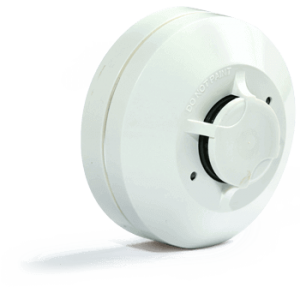
AU101MD/D
Military Standard Addressable Intelligent Multisensor
Ministry of defense products
- Real-time smoke and temperature info
- Smoke/heat sensitivity alteration from the panel
- The address can be changed from the panel
- Detailed location description settings
- Soft addressing
- Pre-alarm
- Contamination alarm
- Remote test facility from the panel
- Electrical supervision
- Transient voltage protection up to 2.4KV
- Corrosion protection
- Insect-resistant screening
- Dual bi-color LED indication for 360° viewing angle
- Easy to maintain/service
Electrical Specifications
Operating voltage: 17-27V DC
Quiescent current : 200uA
Alarm current : 1mA
Altitude : 3000m(above MSL)
Indications
Normal : Green LED(Blinks during scan)
Alarm : Red LED(Glows steady)
General Specifications
Smoke sensitivity : 0.5 – 3.5 %obs/foot
Operating temperature : 0ºC to 49ºC
Storage temperature : 5ºC to 40ºC
Humidity : 0-95% RH(Non-condensing)
Color : White
Housing : Polycarbonate
Compatibility : AU101X Protocol
Contact Clamp: Stainless steel
Dimensions(DiaxH)
without base: 100x34mm
With Base : 100x46mm
What is a multisensor sensor and how does it work?
Multisensor is an instrument that houses both smoke and heat sensors for a more guaranteed fire detection.
The multisensor detector is only a measuring instrument that monitors the level of smoke and heat in its surveillance. It will raise an alarm only when the level of smoke/heat exceeds its pre-set upper limit/threshold values.
Its working functions combine the optical smoke detection principle & rate of rising heat detection principle.
The Photoelectric/Optical Smoke detection part works on a common light scattering principle. A multisensor detector contains a chamber that consists of a light emitter usually a LED and a light a sensitive device like a photodiode that receives all the light directly emitted by the LED.
When the smoke enters the chamber, the intensity of light received by the photodiode reduces due to the density of smoke. If the intensity of received light drops below a pre-set threshold level, the fire alarm is triggered confirming fire.
Further, for heat detection, a thermistor device is used in the detector to monitor temperature levels. The resistance offered by the thermistor device decreases with an increase in heat sensed by it, thereby increasing the values of voltage and current drawn by the circuit. The detector’s intelligence algorithm monitors the difference in voltage values at continuous intervals of time. The higher the difference in voltage, the higher the increase in heat.
In the case of fire, the rise in temperature is rapid. Meaning, in less time the difference in temperature measured is very high. This parameter of the rate of rising in heat is considered to raise an alarm confirming the presence of fire.
The alarm is also raised when the live temperature exceeds the pre-set upper limit/threshold values of the detector.
The unit of measure for the level of smoke is Obscuration/foot (Obs/ft). Similarly, Celsius is the preferred unit for measuring heat levels.
Multi sensors provide more reliable fire warnings by responding quickly to smoldering fires.
